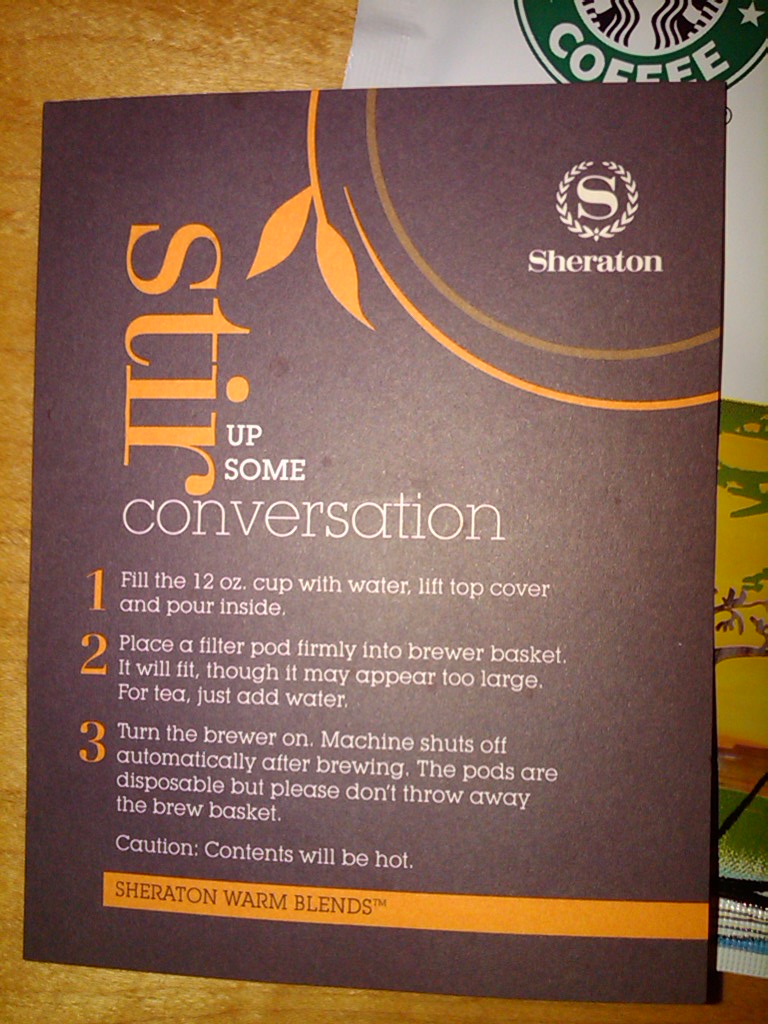Notes From the Road - #1 - Technical Instructions
This is the first in what I hope will be an ongoing series of quick dispatches from the trail - things I pick up from airports, hotels, cabs, meetings - anywhere really, in hopes that at least some of the observations will be interesting and even worthwhile. And also, since being out on the road for work usually throws off the schedule and gives me less time to worry about the little blog here, these Notes from the Road pieces have a internal timer set at 15 minutes. Whatever ideas, no matter how half-baked or thinly developed, get the 'Publish' treatment at the 15-minute mark.
Ready, set, go. Fifteen minutes starts now.
So if you spend any time in hotel rooms you've probably came up against the scourge of many a traveler - the 'in-room coffee maker'. These tiny, devious machines are notorious for being impossible to operate, usually having a series of cryptic line drawings that pass for operating instructions, producing horrible coffee, and generally leading to a disappointing experience overall. Coffee!
Coffee!
I've had many a run-in with these little devils, and two days ago made a gigantic mess by overfilling the machine and spilling hot coffee all over the place, (sorry Aloft Hotel). So this morning when I cautiously approached the in-room coffee maker at the Sheraton in Reston, VA, I was stunned and grateful to see the little instruction card you see on the right of this post propped up in front of the machine.
Why are these technical instructions so effective?
1. They are written in plain language. No jargon, no weird or awkward phrases. They are written like someone would tell you how to use the machine.
2. They address common concerns without condescending to the user. The pod did seem too big to fit in the machine, but it worked just fine.
3. They are dirt simple. Making in-room coffee should be easy. And it almost never is. But by combining a well-designed machine with a just-right set of instructions, (and some quality coffee as well), the entire experience was positive.
Simple, simple, simple. Don't over think your messages, instructions, communications. Write like you'd speak to people, like adults, and like adults that are not necessarily experts in your wonderful new technology or process.
Well done Sheraton.
That's 15 minutes, (give or take), and I am out.

 Steve
Steve
Reader Comments (5)
Steve, you cannot mention in-room coffee makers without talking about the little packets of powdered chemicals they usually offer to whiten the stuff if you manage to make it.
I keep a list of hotels that provide instead the little containers of Nestle's liquid Coffeemate, which needing no refrigeration is probably the same chemicals but somehow tastes better.
Homestead Suites gives them out in the breakfast area 24/7. But first prize goes to Crown Royal Cabana in Palo Alto right on Camino Royale (close to SAP) and not so far from Oracle, which goes a step further and has six real creamers in the fridge. I always stay there.
I had this chat with George Clooney once.
Good observations. I'm starting to think that you're a usability analyst in disguise...
Excellent post, Steve. It applies to so many things. I'm going to start employing the 15-minute Publish cutoff myself. Thanks for the inspiration, and happy travels.
@Bill - Very thorough analysis of the in-room coffee space. Excellent. But I would have thought you and Clooney would have talked about 30 year old scotch, playing baccarat in Monte Carlo, or various super models you may be mutually acquainted with.
@Jennifer - thanks very much!
@Lori - thanks - I like the 15 minute guideline myself!
Learning to write technical instructions is challenging. Writers must consider audience, purpose, context, length, and complexity—plus the specific content of the instructions, such as the steps in using a stapler.